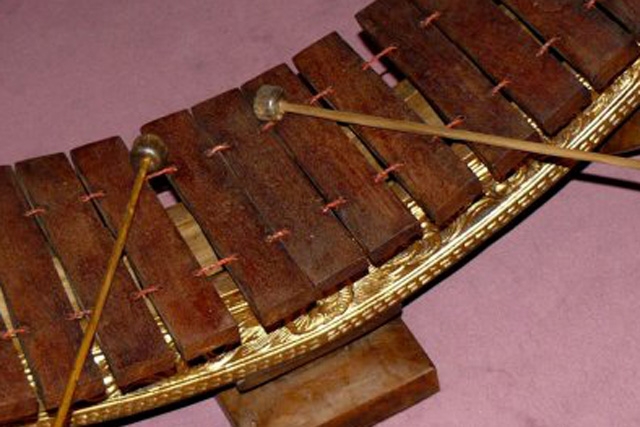The Strange, The Familiar: Foreign Musical Instruments in Myanmar/Burma

by Kit Young
Myanmar/Burmese musicians’ use of foreign instruments in the last 150 years has enchanted the ear of many newcomers to the music of lowland Myanmar/Burma.
Foreign listeners recognize familiar timbres - piano, violin, mandolin,
Hawaiian slide guitar, Chinese lute (byat saun), concertina, euphonium,
banjo, trombone -and delight in a totally new character of sound introduced
by necessity: the need to adapt these instruments to complement and merge
with the Myanmar/Burmese hsaing waing (percussion ensemble which includes
the circle of 21 drums known as the pat waing), pattela (xylophone), saung
gauk (harp) and hhne (oboe). Each new instrument went through an adaptive
evolution which adjusted to the soundscapes of musicians in the Burmese
Royal Court (1800’s), the outdoor village theatre known throughout
Myanmar/Burma as Za’ Pwe and Na’ Pwes, marionette performances
(yokthee pwe) and both silent and sound movies from the 1920’s to
the present day.
U Khin Zaw, a pioneering and lively writer on Myanmar/Burmese music described seeing, in the early 1950’s, a Za’ Pwe performance which combined a hsaing waing group on the right hand side of the stage with a piano, violin, clarinet, brass instruments and a jazz trap set on the left hand side of the stage (a practice that is still in use today at outdoor za’ pews. Nowadays, there is an addition of amplification for younger generation rock bands and an introduction of Hip Hop and Rap songs in Myanmar/Burmese which is sometimes accompanied by the hsaing,). He lovingly describes the blending of instruments:
“Would the two mix well? It depended on the discretion with which the mixture was arranged. Tone, resonance, timbre, capacities and limitations of western instruments are quite different from Burmese instruments. The former might have precision, the latter might have grace. Would there be a sensitive understanding of the nature of the different instruments to exploit their use with discretion? Well, I listened to the overture attentively and enjoyed it from beginning to end.
And he adds, “ The voluminous statement of the brass was retaliated by the eloquence of the hnai (Myanmar/Burmese oboe). The accents of the piano were echoed by the impact of the drums with gusto. The traps were overwhelmed by the bamboo clappers. If this judicious mixture could be extended to the traditional marionette and modern stage, all would be well.”
Sandaya: The Piano in Myanmar/Burma
The pat waing and pattela players in the court of King Mindon at Mandalay (1850’s-1870’s) took immediately to the piano when it showed up at court as a present from the Italian Ambassador. King Mindon instructed one of his ministers, who was on a fact-finding trip to England, to report on various technological wonders of the West - among which was the piano. The King reputedly was interested in acquiring a piano. (Desai) (Hla Shwe)
Present day pianist and composer U Thein Maung of the Myoma Amateur Musicians’ Association suggests two speculative derivations for the word “Sandaya”. The first being the consequence of an elision of two words in Myanmar/Burmese ‘ se' ’ meaning ‘machine’ and ‘yandaya’ meaning ‘complicated parts’. Another suggested etymology was offered as “san de wa wa” or ‘feeling around with one’s hands like a blind person’ which was what the court musicians reputedly did in Mandalay and Ava when the piano first arrived.
But the musicians quickly regained “sight” as the white keys of the piano became equivalents for the keys of the pattela and the substitute pitches for the drums of the pat waing. One finger of each hand approximated the mallet strikes on a pattela or strokes on the pat waing. Musicians experimented with retuning the white keys to approximate their own familiar raised fourth and lowered seventh degrees making it easier to modulate among the Myanmar/Burmese modes.
A completely unique technique of interlocked fingering with both hands extending a single melodic line allowed for agogic embellishment, fleeting grace notes in syncopated spirals around a steady underlying beat found in the bell and clapper time keepers (si and wa). Rarely, in the early days of sandaya was the keyboard terrain divided into bass-left and treble-right hand configurations.
Immediately heard – as a result of this kinesthetic and aural adaptation – were the textures of quickly-released keys, abrupt entrances, sudden accents and decrescendos of sound delighting Myanmar/Burmese audiences with echoes of the pattela, pat waing and saung gauk. Percussive strikes on the keys were the equivalents of mallet dampening on the pattela or the palm dampening the head of the drum on the putt waing. And all of these textures imitated the expressive techniques (han) of Myanmar/Burmese singing.
At the core of Myanmar/Burmese traditional music is the Mahagita or “Great Music” – a collection of verses and memorized song forms passed through generations for the last three hundred years. The various genres of these songs form a pedagogic tool introducing techniques of embellishment, and arranging melodic patterns in improvised sections known as "Ti Kwe" or "Le' Son" (Becker). The musical lines tend to be monophonic with occasional supporting intervals (9ths, 4ths, 5ths predominant) at pivotal phrase points. Melodic phrases weave between lower and higher registers of the octave. As more western instruments were folded into a Myanmar/Burmese musical context, their Burmese properties were discovered and quickly developed.
Silent Movies and Home-Grown Accompaniments:
Cornets, Violins, Pianos, Banjos, Guitars, Trombones and More!
While we can only speculate on the approximate “arrival” points of western instruments into Myanmar/Burma, it is the “burmanization” of these instruments that we can hear on old recordings and imagine through anecdotal history that becomes a point of fascination for the unaccustomed listener.